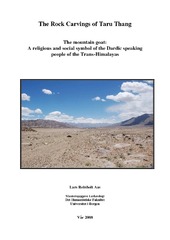| dc.contributor.author | Aas, Lars Reinholt | eng |
| dc.date.accessioned | 2008-11-18T10:14:39Z | |
| dc.date.available | 2008-11-18T10:14:39Z | |
| dc.date.issued | 2008-11-18 | eng |
| dc.date.submitted | 2008-05-15 | eng |
| dc.identifier.uri | https://hdl.handle.net/1956/3042 | |
| dc.description.abstract | A study of the rock carvings of Taru Thang in Ladakh. I have tried to show how the mountain goat symbol so often depicted in the rock art might have been made by Dardic speaking groups in order to map out and understand social differences, in particular those between man and woman. | en_US |
| dc.description.abstract | I have studied the rock carvings of Taru Thang in Ladakh, and linked their origin and meaning to the Dardic speaking people of the trans-Himalayas. I believe it it possible to show, through the use of the concepts of totemism, bricolage, myths and binary oppositions that the mountain goat symbol so often depicted was made, not because it was good to eat, but because it was a potent symbol for thinking, especially to understand and recreate the difference between man and woman. | en_US |
| dc.format.extent | 6166353 bytes | eng |
| dc.format.mimetype | application/pdf | eng |
| dc.language.iso | eng | eng |
| dc.publisher | The University of Bergen | eng |
| dc.subject | Ladakh | |
| dc.subject | Dards | eng |
| dc.subject | Rock carving | eng |
| dc.subject | Mountain goat | eng |
| dc.title | Rock Carvings of Taru Thang. The mountain goat: A religous and social symbol of the Dardic speaking people of the trans-Himalayas | eng |
| dc.type | Master thesis | |
| dc.rights.holder | Copyright the author. All rights reserved | |
| dc.rights.holder | The author | eng |
| dc.description.degree | Master i Arkeologi | |
| dc.description.localcode | MAHF-ARK | |
| dc.description.localcode | ARK350 | |
| dc.subject.nus | 713306 | eng |
| dc.subject.nsi | VDP::Humaniora: 000::Arkeologi: 090 | |
| fs.subjectcode | ARK350 | |
